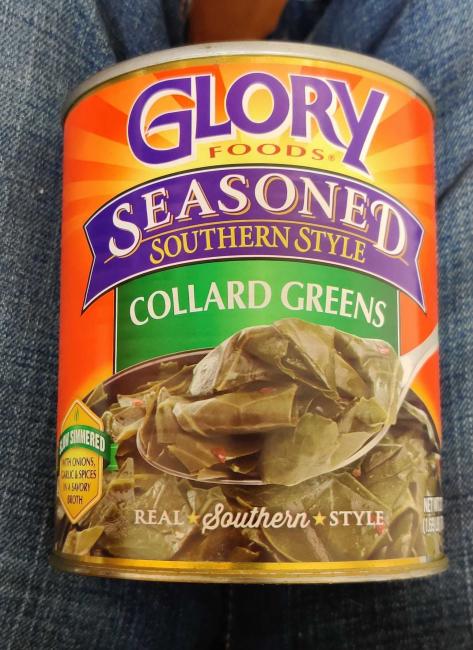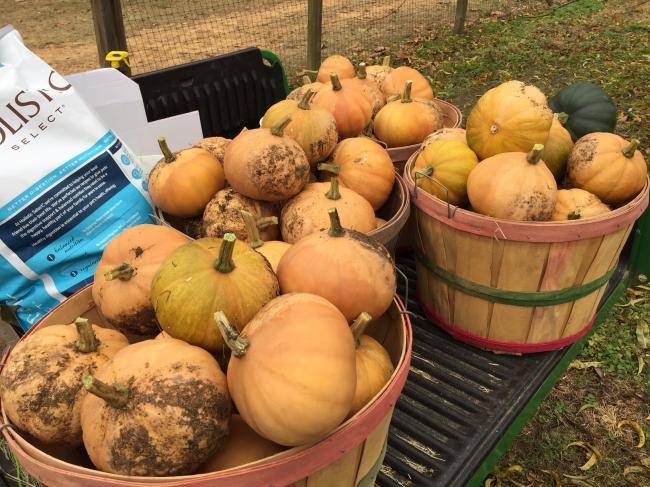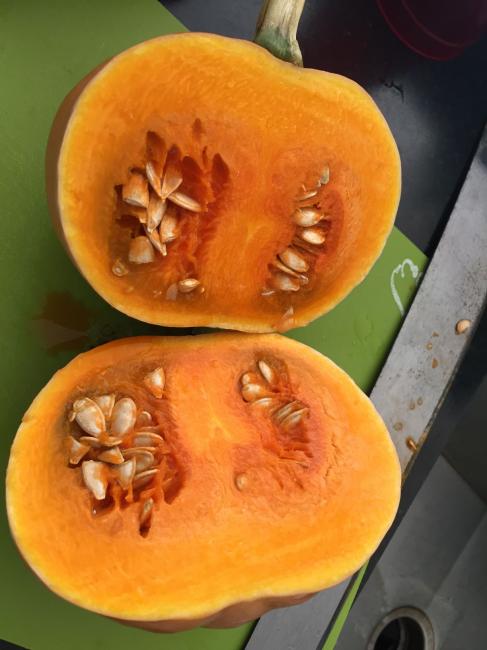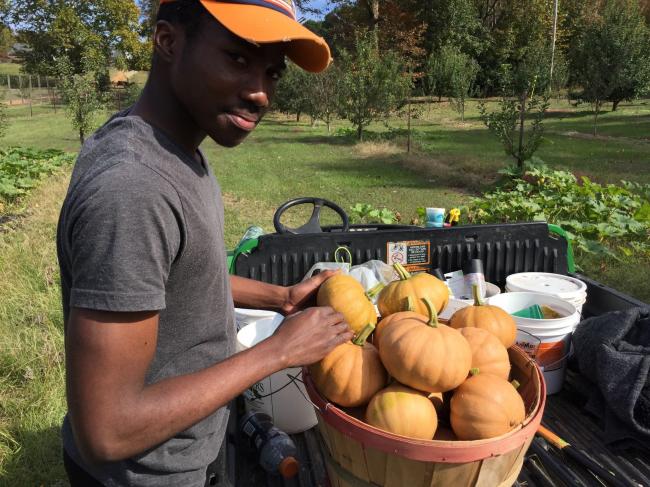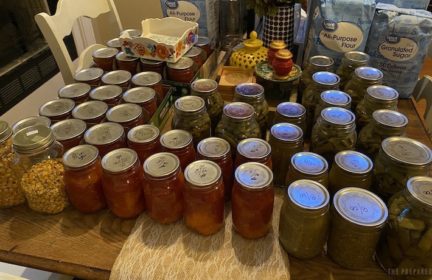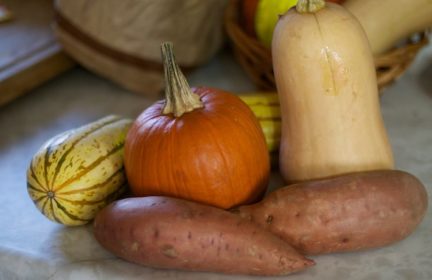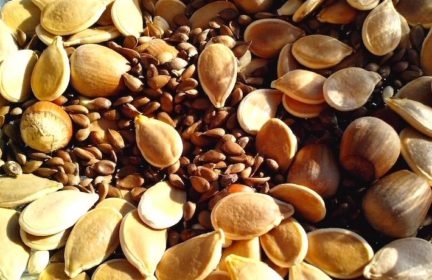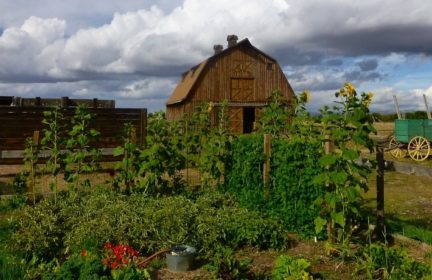Maintain a sustainable food source with the prepper’s garden
In dire straits, many preppers imagine trapping rabbits (beware tularemia and SAS doesn’t recommend relying on rabbit) or hunting (you would be surprised how quickly deer populations can be decimated leaving nothing to hunt). That also applies to fish.
In The Great Depression, resource rich Canadian prairies were virtually hunted and fished out. In the best of times, not everyone hunts or they hunt and fish responsibly. In a crisis, people forget stewardship and why hunting and fishing limits exist.
You would also be surprised at how many people wound deer, don’t track the animal (inhumane and wasteful), and then keeping shooting and wounding more animals. Guess how quickly those fools can decimate the deer population in an area? I’ve seen it.
I grew up with venison, wild ducks and geese and prairie chicken on the dinner table. But, I also remember the “bad” years when Dad, who was a crack shot, couldn’t get a deer. When you hunt you deal with nature not Safeway.
This is why I believe that that the ability to grow food needs to be part of prepping.
The ability to grow food is a part of being sustainable. It is worth it to try to grow a garden and challenge yourself to learn a new skill.
It’s easy to learn the skills or study the subjects we have an interest in, but crisis and disaster call upon preppers to wear many hats and use a variety of skill sets. That means learning skills that are not interesting to some, but very necessary to all.
You may not become a master gardener, but with hands on experience, you will develop a feel for what it takes to produce food. Who knows you may even discover that you really like gardening.
Start simple. Get a good reference book. Try a simple raised bed garden or a balcony garden or use grow lights if in an apartment without a balcony. There are also community gardens in some areas.
We could discuss this year’s gardening efforts and share tips or brainstorm problems. Is anyone interested in doing this as a part of prepping?
-
Comments (36)
-
RedneckContributor - February 27, 2021
Thru the years, I’ve grown all sorts of food in the garden & orchards, but one single thought now dominates when I choose an item to grow… low maintenance. It can be stressful and cause many beginners to give up when they fight diseases/pests and crop failure. So I suggest growing things that are easy to grow and require no spraying of chemicals. Also items that can handle dry weather and maybe even temperature fluctuations.
Case in point… apples. Who doesn’t love a sweet, juicy apple? I’ve got around 150 trees in my orchard, and let me tell you, they are a pain in the arse. Even varieties touted as disease resistant give me fits. I have to spray a good bit of fungicide to get a crop but what I spray is a tiny fraction of the chemicals they spray on the apples you buy at the store. My solution is to gradually replace all my problem varieties with jujube. Before last year, I’d never heard of them before, but they grow a fruit very similar to an apple… just smaller. All the literature says no pests or disease bothers them plus birds & deer aren’t attracted to them. They come from the Orient, and there are called Chinese dates. If you leave the ripe fruit on the tree, as opposed to rotting like an apple, they wrinkle up and look & taste like a date.
IMO, if someone wants to garden with the intent of learning how to provide your family food during a crisis, there are some core plants to start with. I always suggest, and grow myself, the three sisters… field corn, pole beans & winter squash. The native Americans called them sisters. Today we call it companion planting, where different plants provide a benefit to other plants. In this case, the corn grows tall and provides a free, study trellis for the pole beans to climb up & mature. The pole beans, being a legume, put nitrogen (fertilizer) back into the soil for the hungry corn. The winter squash grows low to the ground, and keeps the weeds in check plus holds in the soil moisture by blocking the hot sun. You can grow these crops everywhere but you need to research and test the varieties that work best in your area.
Nutrition is as important as calories, and the three sisters, by themselves, provide almost 100% of the nutrients your body needs. Another class of food extremely high in nutrition and exceptionally easy to grow are greens. Most greens are cool weather plants, which is great as it allows you to extend your growing season and produce much more food on the same amount of land. Down here, I grow mostly collards. I love all greens, such as kale and turnips, but I find collars out preform any other green and are least impacted by a cold spell. Here it is almost March, and I still have collards out in the garden. Granted, they are ugly and stunted now, because of the extreme cold spell a week ago. We had record lows and about a foot of snow that stayed on the ground for a week. Our lows went to zero or low single digits several nights… and the collards are still alive. I didn’t expect them to survive that extreme cold and maybe they will not put out new growth, but the point is, when growing during the spring and fall, an occasional cold spell in the 20s will not harm them in the least.
Now the easiest plant to grow, and the most versatile, as well as being amazingly nutritious is amaranth. It is the one seed every prepper should keep. A pound of amaranth seed, which would fit in a quart jar, is over a half million seed and each plant can produce anywhere from a half pound to a pound of seed… EACH PLANT. Each little seed grows a plant larger than corn and the entire plant is edible at certain stages of life. When young, you can eat the whole plant, stems & all. As the plant gets larger, the young leaves can be eaten raw in a salad, while the larger and older leaves can be cooked. The seed can be ground into a gluten free flour. Wild amaranth is a weed which is almost impossible to kill. Cut it down and like grass, it comes back. Now some weed varieties are immune to Roundup. The attributes that make it such a pain for farmers make the commercial varieties priceless for preppers. It loves hot weather and like a weed. handles drought extremely well.
Finally, I’ll add it would help you greatly if you could put in some easy to grow perennials… plants that come back every year on their own. Besides the jujube, I’d suggest and personally grow blueberries, blackberries, muscadine grapes and some nut trees such as pecan.
Sorry to ramble but this is near & dear to my heart.
-
UbiqueContributor - February 27, 2021
I was hoping you would lead the input on this.
I read about the jujube trees and the one thing I noticed was that they are considered an invasive species. From what I understand that can be controlled, like how bamboo grown as privacy screens is controlled by planting in planters underground.
The points you made about apples remind me of the Okanagan when I lived there. Because it was a fruit production area, there was mandatory chemical use if you had even 1 apple tree in your back yard.
There is a lot of maintenance or disease/pest problems with certain crops and it is a good point for the beginner gardener to know when they research what they want to grow.
Also, like food storage for preps, it is important to grow what you will eat.
Please comment freely, Redneck, you have experience and have experimented with various crops. There is much everyone can learn from you.
-
hikermor - February 27, 2021
In the typical aboriginal hunting and gathering society, harvested game was welcome and appreciated, but most of the day to day food came from gathering plant products – world over. Plants don’t run as fast
-
Carlotta SusannaStaff - February 27, 2021
That’s also one of the reasons why we moved from hunter-gatherers to farmers.
-
UbiqueContributor - February 27, 2021
Well said, hikermor. That is how hunter/gatherer societies functioned.
My Dad never left anything to to waste from his deer hunt. Suet was combined with other items and used to sustain birds. The hide traded for gloves.
We ate what he shot and yet we still had a huge garden, plus foraged for berries. The foraging on our property for saskatoons was a daily activity as they represented a large portion of our fruit for winter.
Nothing is worse than people who can load and shoot, but have no clue how to hunt while galloping through the countryside with “buck fever”.
Two of my cousins were almost blown off a tractor and square baler because the person who shot at them (and the equipment) thought it was a deer.
We don’t need fire arm safety courses for some hunters, we need IQ tests.
-
RedneckContributor - February 27, 2021
As a prepper, I love the term invasive species. That means these species, both plants & animals, can by their very nature out reproduce and overtake anything it competes with for space & other resources. Invasive species are the champions of evolutionary development. Imagine using such invasive species to help you survive a crisis.
I grow bamboo as well as now jujube. Both, especially bamboo are considered invasive. Is that a bad thing, especially in a survival situation? Is it a bad thing that a 50 foot tall bamboo gets that size within 2-3 months? Harvest that 50′ tree & next year you will have another. In a patch, you can safely harvest around 1/3 of the bamboo each year. Bamboo produces new canes (culms) in the Spring. These shoots emerge out of the ground and grow in height and diameter for around 60 days. After the 60 day period of growth, the bamboo cane never grows in height or diameter again. Yes, bamboo can grow & spread rapidly, but again, grown in the right environment (not next to your house or driveway) that is a huge advantage. Not only can you build things from the wood, but you can eat the young shoots. Control is not a problem for me. I have a patch on the side of my horse paddock. I have to fence in the bamboo, otherwise my horses will strip all the leaves off. They love them. They also love to eat the new shoots each spring, so the bamboo never invades the paddock. On the backside is my neighbor’s pasture. Once again, the bamboo hasn’t spread in there because the cows likewise love the shoots.
Jujube is considered invasive because the trees can produce shoots from their roots, creating a large patch of jujube trees. Once again, I consider that a positive if grown in the right environment. These shoots are the primary way growers get new jujube trees. You dig them up when young, establish it in a new, more desirable setting, do a simple graft to a commercial variety (your original tree, such as Li) and pretty soon you have an orchard for no cost. Jujube are very precocious, meaning they will set a crop even on a two year old tree.
Amaranth is most certainly an invasive species, because it is basically a weed. It is extremely hardy, recovers when cut and produces hundreds of thousands of seed per plant which will reseed easily & naturally. Last fall I cut down my small patch of amaranth that I was growing for summer greens & put the huge plants in my compost bin. Just by handling the plants, they shed seed in that garden bed and down the paths to the compost. Within a week, I had many thousands of tiny, pink amaranth plants growing in that bed & walkways.
As someone who strives to learn how to be self sufficient, invasive species work great for me.
-
UbiqueContributor - February 27, 2021
Thank you for confirming what I was wondering about the usefulness of invasive species. Also, much appreciate the details on bamboo, jujube and amaranth.
I’d have to check, but I think Amaranth was grown in these parts at one time.
I am curious now about this region, and am going to do some research on the history of weed designation and crop production for the area.
-
RedneckContributor - February 27, 2021
I believe you live in the far north now. You obviously have different growing conditions than me, being in north Mississippi. However a bit of research will allow you to find the varieties that work in your environment. The downside of being so far north is a shorter growing season but the upside is, food preservation is easier.
Buffalo Bird Woman was an Hidatsa native American born in 1839 along the Snake River in North Dakota. She was an expert gardener using practices centuries old. In 1917, Buffalo Bird Woman’s Garden was published, giving great detail on growing crops & storing them. IMO, it is an incredible book that explains how these “primitive” people, with no modern tools or chemicals, were able to flourish for centuries… until the white man ran them off. I would think you might get a lot of insight into what crops to grow and how to store. Actually the book is better suited for you than for a southern gardener like me, however some practices are universal.
I think if you let her be your guide, then you could use modern resources, such as the agriculture departments of local universities, to find the best varieties to test in your home garden. You might can still find some of the ancient varieties grown by the local native Americans.
-
UbiqueContributor - February 27, 2021
It’s hard to believe that I am only 20 miles off the border, so yes our weather here is very much North Dakota. Although, we have a strange pocket of protection from much of the really adverse weather (except North to South polar vortex).
There is a land formation called The Turtle Mountains, so named by the Anishinaabe People. From what I was told, they originally started many years ago at the Eastern Coast of Canada. There were people in their tribe who prophesized over time, and so they journeyed across Canada until finally they stopped, going no further than The Turtle Mountains.
It’s funny, I wasn’t raised in this part of Manitoba, but it has always felt protected here somehow, and that was before I knew of the story. The Peace Garden is in these parts also.
Their journey and the prophecies were called The 7th Fire Prophecies. It is an interesting read.
I have Buffalo Bird Woman’s book ready to order and thank you very much for the info on her work. It is amazing how anyone could think people with such understanding of nature could ever be called primitive.
There is a seed company in Morden Manitoba callled Heritage Harvest Seed. I have ordered from them before. They don’t ship outside of Canada, however, they do have incredible old and rare varieties of seed, especially legumes and grains. You might enjoy their catalogue and maybe can source some of their varieties through suppliers out your way.
The University of Manitoba Agriculture Department would be an excellent resource, plus Morden Manitoba also has a test center for plants.
Thank you for all the great info.
-
RedneckContributor - February 27, 2021
You are welcome and agree completely on the native Americans. There is much preppers could learn from their practices as they didn’t beat the land into submission… they lived in harmony with it.
My wife & I visited the Peace Garden back in the early 80’s. We were stationed in Minot, ND, which is just a few miles from there. I’m actually pretty familiar with that whole part of North Dakota because our missile sites are spread all over that part of the state. I think I pulled alerts in all 15 launch control centers.
-
UbiqueContributor - February 28, 2021
That is precisely the term – living in harmony with the land. That is where the wisdom lies.
I still see farmers in some areas here ploughing their fields before winter. They leave nothing to hold the top soil. Some are wiser and know what happened during the depression when farmers watched their top soil blow away.
The Peace Garden is lovely. Friends of ours got married there some years ago.
I never thought of how stressful it must have been to deal with the alert part of that work. Some people think of missile sites as being “active” only upon launch. but the majority of the work is in how those who are stationed there monitor, guard and watch over everyone. It is a front line of a different kind and to pull that many alerts is a lot of very stressful action. Thank you for your service.
This is an article I ran across this morning from BBC about how other cultures are tackling food growing problems:
-
Gideon ParkerStaff - February 28, 2021
Hey Redneck! So I was out shopping the other day and thought of you when I saw this.
Haha I already know what you are going to say! But as I’m preparing and eating this, I’ll just have to imagine the real thing being better than the canned stuff. I had to at least try it to see if this is something i’d like to try and grow.
I’ll let you know when I dig into it. Kinda nervous…
-
RedneckContributor - February 28, 2021
Yep, you know what I’m gonna say! Canned veggies like that are nasty to me… plus not healthy. I would bet you soon can find fresh collards at your grocery. I will say, even many southerners say they don’t care for collards and would rather eat turnip greens. I never ate collards as a kid… only turnips. For some reason, way back then, eating collards was associated with black folk. I never hear that anymore. More & more common to see them as a side dish in fancy restaurants now.
Funny story. My wife spends Wednesday thru Sunday in Memphis with her 100 year old aunt & 99 year old mom. Every Tuesday night, I fix a big dinner so that my wife can bring them some healthy leftovers. I do collards about every three weeks. One week, my wife stopped at a chain home style restaurant to provide dinner for those two. She got them turnip greens. As her mom was eating, she told my wife something must be wrong with me, as those greens just weren’t anywhere near as good as normal. They have gotten spoiled. 🙂
I now also provide leftovers for an elderly lady from church that lives alone. For that meal, I cooked my Tuscan kale same way I do my collards. That kale tastes almost identical to collards and has the same great texture. She said that was the best greens she ever ate and didn’t think she liked kale.
I hope you grow to love collards. They are exceedingly healthy and so easy to grow. They are a great crop for preppers.
-
UbiqueContributor - February 28, 2021
Collard greens are called Borekale in Canada, and some stores do stock it under Collard Greens, however, not nearby, in Alberta. I am going to search out the seed.
I posted a note about Beet Tops below to Gideon. They are my favourite vegetable. Last year I harvested bits of the beet tops at a time as I did with the Giant Fordhook Swiss Chard I grew. I didn’t know when I selected that type of chard, but it is the only one that has edible stocks.
Big pat on the back to your wife for caring for her mom and aunt. It is our family tradition to care for our loved ones, too. That is a nice compliment on your cooking to hear feedback like that from your mom in law. Also kudos to you for caring for your neighbour by sharing food.
Oh, I am going to try cooking kale as you do collards. I just noticed that. I cooked the Curley Kale I grew last years but wasn’t as taken with it.
Definitely, I am looking for crops that can last or get better with a bit of frost. Kale is supposed to be good for that. Now I will be able to make it taste nicer. Thank you.
-
Hermit - March 1, 2021
Redneck, first of all, thanks for your contributions to this forum. I’ve learned a ton from you already.
Do you recommend any particular variety of jujube? We’re going to try some fruit trees this year, and might as well throw one of those into the mix.
The amaranth is already in the plan.
-
RedneckContributor - March 1, 2021
Thanks for the exceedingly kind words. I ordered both Li and Lang and those seem to be accepted as very common varieties. Both are of a good size with nice sweetness. Dave Wilson Nursery, who grows many jujube for other online retailers, says they grow as much Li as all other varieties combined. If I had to choose just one, It would be Li, as it really doesn’t need a pollination partner, where Lang does. Their video is very informative.
I’m currently trying to get some jujube seed to sprout. If I have success, I’ll graft them over to Li next year.
-
Hermit - March 1, 2021
Glad to see your recommendation of the Li variety. A local nursery stocks those, so I’ll probably be paying them a visit.
-
-
Gideon ParkerStaff - February 28, 2021
I edited the title to hopefully make the point of the post clearer for other people. You’re welcome to edit it more.
-
UbiqueContributor - February 28, 2021
Hi Gideon – I love the title! Seriously – you are way better at creating titles than I am. Please feel free if you have a better idea, anytime. I really appreciate your help.
By the way, once you eat those Collards, how about Beet Greens?
They are my favourite vegetable. Some people won’t eat them for the misconception that they are like Rhubarb tops (which are poisonous).
Beet Greens are absolutely safe to eat and the stem part is tender and also edible. They boil or steam fairly quickly and are wonderful with butter.
They are very healthy, too. (I know, butter, but still…)
The Ukrainian people used to make Beet Holubsti (word for Cabbage Roll) by wrapping left over bread dough (from bread making day) with a raw beet leaf, rising and baking it on greased sheets. Then a Smetana sauce of farm cream and chopped green onion simmered together was poured over them.
I have made them and although they don’t sound exciting to eat – they are soooo goood. Plus they will give you enough energy to get some collards planted.
-
Gideon ParkerStaff - February 28, 2021
I’m glad you like the title. 🙂
I’ll have to keep an eye out for beet greens as well, thanks for the suggestion. And you are right, that Beet Holubsti doesn’t particularly sound good to me, but i’ll take your word for it and try it if I ever see it for sale. I might be able to find it at a European restaurant.
Have a great week Ubique!
-
-
Josh CentersContributor - February 28, 2021
I can’t recommend butternut squash enough. Easy to grow, high in calories, mild in flavor, and lasts all winter without special storage.
-
Olly Wright - February 28, 2021
When you say it lasts all winter, is that after you have harvested and it is just sitting in your pantry?
-
RedneckContributor - February 28, 2021
Yes it is easy to grow and exceedingly healthy. I grow it as sister squash often.
For folks in the deep south, I highly recommend Seminole Pumpkin. It is not a pumpkin in the way we think of one. It is same species and similar to butternut squash. They can store all winter in hot humid Florida… where it originated. To me, they taste similar to a sweet potato.
Harvesting some from my orchard. I let them grow between my trees.
Here is a college student from Nigeria helping me harvest. We both learn much from each other.
-
RedneckContributor - February 28, 2021
You harvest it, make sure the outside skin is clean and store it in a cool spot that will not freeze. For me, that is my garage. In colder climates, it probably means the basement or similar.
-
-
Mrninjatoes - March 1, 2021
I want to setup an indoor garden for potatoes. I am looking into solar powered lights so if there is grid failure I can keep my taters going. Anyone tried this?
-
RedneckContributor - March 1, 2021
I use grow lights for seedlings in my trays. To provide grow lights for a batch of indoor grown potatoes would require a whole lot more. Only solar powered grow lights I’ve seen are rather small, with the small solar panel built in. I can’t see where that would help you. Only way I see it happening would be if you had a solar generator & associated panel, that could then power your normal grow lights during a grid down situation. I have no idea what their power usage would be and really wonder if you would want to use such a resource for grow lights?
Keep in mind if you are growing them inside during the winter, which is the only reason I can think of for growing them inside, then it will be just as important to keep them warm… and probably more so. A plant can do without sun for days, but one night of cold temps and they die.
-
UbiqueContributor - March 1, 2021
Just to confirm, you want to do this in a greenhouse? I ask because humidity can be an issue in the home.
-
Mrninjatoes - March 1, 2021
A basement. I live in the Southwest so it is a very dry climate.
-
UbiqueContributor - March 2, 2021
Mrninjatoes – Understood. Your conditions are much different. Thank you.
-
-
Pops - March 2, 2021
A garden is a big chore. Not the little salsa garden with a couple of tomatoes and some cilantro, but an actual energy positive food source. I’ve had gardens big and small, some beautifully tended gems, some pretty big near truck farms that consumed my life and included patches abandoned to the weeds in shame.
Likewise the typical conundrum of “prepping” is that things easy to store at scale aren’t always the things normally used. And gardening is the same, practicing at scale is time consuming and expensive.
A year ago we were in Washington and about to flip the house we had been fixing but I stopped everything and planted the backyard with potatoes, peas, then corn, beans and squash as soon as the first COVID community spread case was reported. Even though I had a stash of heirloom seeds and went out and bought as much seed as was available at the end of February (they went fast!) I still needed to plant potatoes from the grocery store and beans from storage.
That wasn’t really a “sustainable” garden, it was a pandemic survival garden (when after much hand-wringing we did sell, the buyers were excited about it, LOL). But the point I wanted to make is that in my mind a prepper’s garden is about not going hungry in exigent circumstance but not being a huge time sink otherwise.
I used the prepper’s best friend, garbage bags, and some black plastic I had to kill the lawn then just planted through it. It is a mess to clean up but holding back the initial weeds until your crop gets going is a key. Use paper of any kind, cardboard, leaves, mulch of any kind to stay ahead.
Lots of great ideas in this thread, perennials of course being the most sustainable food source: fruit, nuts, brambles, berries, asparagus and volunteer grain are the original permaculture and blend into the landscape stealthily and if you pick old native varieties they probably require fewer chemicals.
After the “live-fire” exercise of the last 12 months the ideal sustainable prepper’s garden I imagine would be one that can be as small as a flower bed when life is good surrounded by plenty of “stealth” perennial food and open space— but could be expanded at the drop of a stay at home order into a massive calorie and even trade resource.
In this garden the majority of square footage would not be garden as a rule, because I can make more money and buy more food doing my day job —when I have one. The majority of the area, the Stealth Plot, might be a green manure cover crop of annual alfalfa/clover/grain in some combination or if it is more public maybe an easy to kill clover you could simply plant through, it could even look somewhat like a lawn using a fast growing annual rye grass you could mow and compost with leaves, etc.
Lots of books tell you how you can feed a family of 17 on 12 square feet, don’t believe it. Plants are solar collectors and they take space. And bugs , drought, failure to sprout, wilt, weeds, critters, neighbors all get their share and you need to plan for them too.
Raised beds are pretty and neat and great for perennials if you have excess money and time but in the event you need to grow lots of calories, time and money won’t be in excess I think, so plan on and practice plain old rows—they can be raised for wet climes and sunken for dry.
Then in the “garden” part of the garden (a much smaller plot that could be rotated to different areas of the stealth plot yearly) I would practice and test, experimenting with open pollinated crops to find and adapt the best seed to keep on hand should I ever need to implement the Big Plan.
Misc: Buy one of Baker Creek’s seeds collections to get started (they may be out this year come to think of it) Collect newspaper (old fashioned un-coated kind) or invest in rolls of degradable mulch if you find it cheap. Collect rainwater. Test and amend the soil of the entire plot. Stock up on Miracle Grow, it ain’t a sin.
Gosh, I’ve given myself Spring Fever!
-
UbiqueContributor - March 2, 2021
Hi Pops, Great first hand account of gardening and much appreciate the practical points.
On a town lot, I won’t be producing enough to feed two people, but it will help. The main reason for me to garden, is to keep (and devlop) my skills. Balcony gardening in the city or no gardening in the years I wasn’t able to garden equates with skills lost for me.
I have been reading and experimenting with the hope that if I ever could go larger (acreage) or had to plow up the yard and grow edibles in every inch of it, then I would have a better chance of success.
Frankly, I would rather have a meadow for beneficial insects than a “lawn” any day.
Spring Fever is contagious – the weather has warmed up here and I have gardening books spread out everywhere!
Thanks again.
-
RedneckContributor - March 2, 2021
I’m one of those that keeps a modest sized garden, but am ready to greatly increase size during a crisis. I keep enough seed in storage so as to not need to run to the coop after a crisis, and hope there is some seed left. IMO, amaranth is the perfect stealthy crop. It looks like a weed, is easy to grow, versatile as a leaf vegetable and a pseudo grain.
I’m not ashamed to say I keep lots of Roundup (glyphosate) in inventory. I use it sparingly but it is extremely helpful in clearing grass and weeds in a hurry.
-
-
LBV - March 3, 2021
I have a small section 350sq/m (1148sq/ft) in a temperate climate where we have snow once every 20 years. My orchard is probably the most low maintenance part of my garden. My apples are perfectly fine with no spraying at all. Several gardeners in our village swear by peppermint pelargonium to prevent codlin moth. My apple varieties are all old heritage varieties. Peaches are black boy and hiawatha which are productive with no disease. Elderberries for syrup. Feijoas as they are easy work. They are ripe when they fall off the bush. Figs because they are delicious. I am also a fan of persimmons but struggling to get the astringent variety. I have not really had any problems at all with my orchard, especially for the minimal effort
-
UbiqueContributor - March 3, 2021
LBV – Your orchards sounds wonderful! A temperate climate certainly opens up so many possibilities with gardening.
Pelargonium is a wonderful plant and beautiful in the garden. I have heard of the peppermint variety (in the leaves, I believe?) as a insect deterrent.
I looked up Feijoas as I had never heard of them before. The description of their flavour sounds delicious. How I envy your ability to grow these crops.
I also like the point about elderberries for syrup. Many times we forget that is also a way of preserving our fruits.
-
-
UbiqueContributor - March 6, 2021
Here is some interesting info on vertical gardens from the BBC:
BBC How to grow food in concrete jungle
Aeroponic gardening is another way to grow food with less water. They have experimented with this type of gardening in in Vancouver BC
CBC news Vancouver BC Large Aeroponic farm
-
MissyH - January 19, 2022
I think ability to grow food is the #1 most important thing! You literally can’t do anything else without calories. I’m a professional grower (I own a small farming business besides my “real” job). I agree with the other commenter apples are a PITA, unreliable at best. I’d grow ground cherries instead, an heirloom forgotten fruit.
Maybe I should teach growing, its easy as long as you pay attention to sprouting requirements (light, no light, cool temp, warm temp, humidity). Its not rocket science but I think people are incredibly intimidated by growing. I can grow anything honestly but yes sometimes I kill stuff but I tweak my method and start again. For example microgreens start to finish take only 12 days. That’s an amazing nutrition source ready in less than 2 weeks. Also remember you need to know how to gather seeds! Another lost art.
I’m also taking courses on medical plants, so many are packed full of vitamins, natural antiseptic or even antibiotics. I’m also growing medicinal plants myself or gathering them. There are plants currently being researched as replacements for our current antibiotics due to bacterial resistance. A much better idea than stockpiling medicine that expires.
Also don’t forget cold frame growing with cool crops. I watched a video by a guy in zone 4 in Canada grow kale and other greens year round with a cold frame and row cloth.
Growing and gathering is a huge important subject that alot of people know nothing about because our society is based on manufacturing food.
-
- Neutrality for the sake of survival and how to manage the full spectrum of ideologies - 13 hours ago
- Essential medical reference books for the prepper library - 16 hours ago
- News for the week of 2024-07-22 - 16 hours ago
- AR15 stock weight - 4 days ago
- Burning Candles - 5 days ago
This forum is heavily moderated to keep things valuable to as many people as possible. Full community policies are here. The basics:
- 1. Be nice to each other.
- 2. Stay focused on prepping.
- 3. Avoid politics, religion, and other arguments.
- 4. No unfounded conspiracies, fake news, etc.
- 5. Debate ideas, not people.
